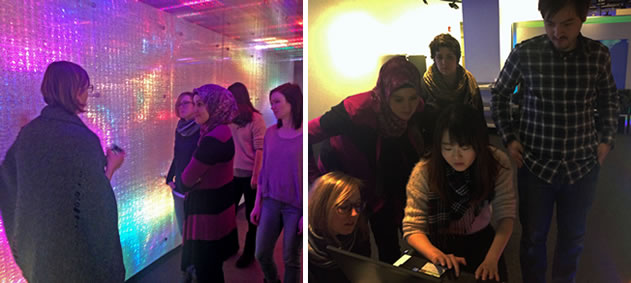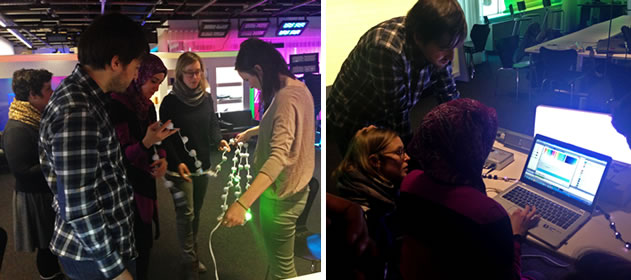A sideways triangle means “play.” A red hand signals “don’t cross.” A white outline of a woman in a dress indicates “women’s restroom.” These are some very basic symbols that translate information without anyone thinking twice about from where they came.
But the power of those symbols and the visualization of information mean a lot more to six graduate students atNortheastern University than many would realize. Just blocks from Boston’s famed Fenway Park, these students and two inventive professors are thinking very differently about the way data is presented and interpreted, and specifically how light can be used in new ways.
Information Design for Dynamic Media and Light is a required course, part of Northeastern’s Master’s program in Information Design and Visualization, where students learn to translate and communicate information into visual, physical, and virtual forms.
Susanne Seitinger, City Innovations Manager at Philips Color Kinetics, and Dietmar Offenhuber, a Northeastern assistant professor, collaborated to create the course objectives, to teach the students, and to demonstrate the power of outdoor lighting systems in urban settings.
“It’s all about taking complex data and visually explaining it,” said Lauren McCafferty, an Information Design student from Cleveland.
The class includes three projects, which focus on different elements of data dissemination and human interaction with information.
The first project requires the creation of an ambient information display powered by a live data feed from an external source. Ambient displays are designed to blend into the environment so that people can absorb the information without needlessly distracting their attention. Ambient displays can be as simple as a screen displaying real-time weather updates in the lobby of hotel.
 |
|
(photo courtesy of Philips Lighting) |
The biggest challenge for the students, who have mainly graphic design backgrounds, is learning to code and program computers to visualize information in a new way. It also took a new set of muscles to think about light as more than an illumination source. The students are now seeing light as a material to translate data into an easily digestible form.
The students concentrate on practical applications of their new skills. “The goal is to create interactive or contextual visualizations, and to come up with a project that lives in the real world and gets responses from people,” Offenhuber said.
 |
|
(photo courtesy of Philips Lighting) |
The second project involves creating a personal mobile information display. The students build their own Android apps with basic interactive features.
The final project, a group effort, is a temporary installation at Northeastern that displays visual information about the campus, building, or students. “The final installation will be interactive light that is also ambient,” said Rania Mona Masri, an Information Design student from Michigan.
As part of the final project, the class will make a proposal to Northeastern about how to create visual icons for each building. “We plan to propose an information system for the university that represents the buildings and tells about their environment,” Offenhuber said.
For this final project, Offenhuber and Seitinger partnered with Philips Color Kinetics, which has a strong relationship with Northeastern University through its co-op program. Twice a year, the Burlington-based company hires between 10 and 15 student employees. Philips Color Kinetics is contributing in-kind donations and materials to the Information Design course for the students to use on their final project to be displayed for one week near the end of April.
In the second part of this series, the students and professors will share their thoughts about how light can be an integral part of information display.





 CN
TW
EN
CN
TW
EN







